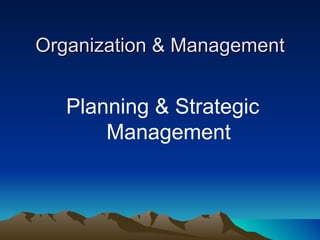Planning
- 1. Organization & Management Planning & Strategic Management
- 2. Planning â The successful establishment and attainment of GOAL coordinated with the successful modification of the organizationâs structureâ
- 3. Planning Basic process we use to select our goals and determine how to achieve them. Process of establishing objectives and suitable courses of action before taking action.
- 4. Planning Every managerâs job Before managerâs can organize, lead, or control, they must make the PLANS that give purpose and direction to the organization â deciding what needs to be done, when and how it needs to be done, and who has to do it.
- 5. Planning The need for planning exists at all levels and actually increases at higher levels, where it has the greatest potential impact on the organizationâs success. Variation in planning responsibilities depend on the organizationâs size, purpose and on the managerâs specific function or activity
- 6. Decision Making An important aspect of planning Process of developing and selecting a course of action to solve a specific problem. May be made at any point in the planning process
- 7. Four basic Steps in Planning Develop a set of Actions
- 8. 1. a Goal or set of goals Indespensable part of planning What the organization or subunit wants or needs Identify priorities and being specific about aims
- 9. Reasons why some managers hesitate to set goals Lack of knowledge of the environment Lack of Confidence
- 10. 2. Define the present situation How far is the organization falling short of its goal? What resources are available for closing the gap? Open lines of communication â necessity for this stage
- 11. 3. Identify Aids and Barriers What factors in the internal and external environments can help the organization reach its goals? What factors might create problems? Essential part of planning â anticipating situations, problems and opportunities
- 12. 4. Develop a Course of action Step in which decisions about future action are made and during which the guidelines for effective decision making are most relevant
- 13. Planning & Controlling Plans are implemented through detailed actions aimed at realizing specified objectives. It is at this action-taking stage that planning moves into another function â controlling Controlling â process of ensuring that actions conform to plans. It cannot take place unless a plan exists and a plan has little chance of success unless some efforts are made to monitor its progress
- 14. Budgeting Most common link between Planning and Controlling A budget is almost always a key part of the planning process because it guides decision about allocating resources toward the attainment of goal;
- 15. Although the planning and controlling are linked, there are advantages in keeping the two functions formally separated. It emphasizes the importance of each; it encourages employees to take control seriously and to ensure that relevant activities are not neglected or performed haphazardly
- 16. Two main types of plan Strategic Plans â focuses on the right thing( effectiveness) Operational Plans â focuses on doing those thing right (efficiency)
- 17. EFFECTIVENESS ability to determine the appropriate objective â doing the right thingâ EFFICIENCY ability to minimize the use of resources in achieving organizational objectives â doing things rightâ
- 18. Strategic Planning Designed to meet the broad objectives of the organization â to implement the mission that provides the unique reason for the organizationâs existence Planning activity of an organization in which top managementâs role is most crucial because coordination of the organizationâs functional areas become crucial
- 19. Operational Plan Provide details as to how the strategic plans will be accomplished Planning done at lower level
- 20. 2 main type of Operational Plan Single-use plans are developed to achieve specific purposes and to be dissolved when these have been accomplished Standing plans are standardized approaches for handling recurrent and predictable situation
- 21. Single-Use Plan Detailed courses of action that probably will not be repeated in the same forms in the future Major types: program, project and budget
- 22. Types of single-use plans 1. program â covers a relatively large set of activities; shows (1) the major steps required to reach an objective, (2) the organization unit or member responsible for each steps, and (3) the order and timing of each step
- 23. Types of single-use plans 2. Projects â are smaller, separate portions of programs of limited scopes and distinct directives concerning assignments and time
- 24. Types of single-use plans 3. Budget â formal quantitative statement of resources allocated to specific programs or projects for a given period; statement of financial resources set aside for specific activities in a given period of time - primarily devices to control an organizationâs acts and are thus important components of programs and projects
- 25. Standing Plans An established set of decisions used by managers to deal with recurring or organizational activities Once established , it allows managers to conserve time used for planning and decision making because similar situations are handles in a predetermined, consistent manner
- 26. Types of Standing Plan 1. Policies â general guidelines for decision making; sets up boundaries around decisions, including those that can be made and eliminating those that cannot. 2. Procedure â a standing plan of detailed guidelines for handling organizational actions that occur regularly; provides a detailed set of instructions for performing a sequence of action that occurs often or regularly
- 27. Types of Standing Plan 3. Rules â standing plans that detail specific actions to be taken in a given situation; are statement that a specific action must or must not be taken in a given situation. - most explicit of standing plans and are not guides to thinking or decision making, rather, they are substitute for them.
- 28. Presented by: Rinalyn G. Magtibay Batangas State University MAED EM



























